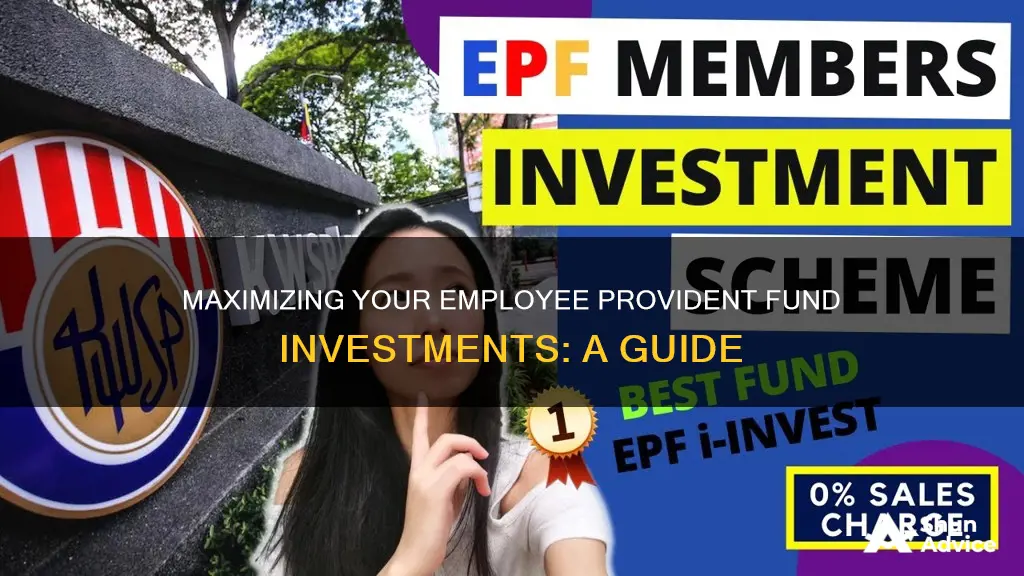
The Employees' Provident Fund (EPF) is a retirement savings scheme where both the employee and the employer contribute a certain sum each month until the employee retires. The EPF is a mandatory scheme for salaried employees with a monthly income of less than Rs. 15,000, and it offers tax benefits and higher interest rates compared to other savings schemes. The EPF is administered by the Employees' Provident Fund Organisation (EPFO), which promotes employees to save funds for retirement and offers various schemes and services to its members.
| Characteristics | Values |
|---|---|
| Type of Fund | Retirement savings scheme |
| Who can invest | Salaried employees earning less than Rs. 15,000 per month |
| Contribution | 12% of the employee's basic salary and dearness allowance |
| Interest Rate | 8.15% p.a. |
| Withdrawals | Partial or complete withdrawals are allowed under specific circumstances |
| Tax Benefits | Contributions are tax-deductible up to Rs. 1.5 lakh per year |
What You'll Learn

Understand the contribution terms and conditions
Understanding the contribution terms and conditions is an important aspect of investing in an employee provident fund. Here are some key points to consider:
- Contribution Rate: Both the employee and the employer typically contribute 12% of the employee's basic salary and dearness allowance towards the provident fund. This contribution rate may vary depending on the country and specific fund scheme. It is essential to review the applicable contribution rate for your fund.
- Employer's Contribution Breakdown: It is important to understand how the employer's contribution is allocated. In some cases, a portion of the employer's contribution may go towards the Employees' Pension Scheme (EPS) or other similar schemes. This allocation will impact the overall retirement benefits you receive.
- Voluntary vs. Mandatory Contribution: In some countries, contributing to a provident fund is mandatory for employees, while in others, it may be voluntary. It is important to understand the nature of your contribution and the implications for opting out or contributing less than the recommended amount.
- Tax Implications: Contributions to provident funds may have tax benefits. For example, in some countries, contributions up to a certain limit may be tax-deductible. Additionally, interest accrued on the provident fund may be tax-exempt up to a certain threshold. Understanding the tax implications can help you maximise the tax benefits associated with your contributions.
- Withdrawal Restrictions: Provident funds usually have restrictions on when and how you can withdraw your contributions. For example, there may be a minimum vesting period or specific conditions under which you can withdraw your funds. Understanding these restrictions will help you plan for the future and ensure you can access your funds when needed.
- Investment Plan Selection: If your provident fund offers different investment plans, it is important to choose one that aligns with your financial goals and risk tolerance. Consider seeking professional advice to select the most suitable investment plan for your needs.
Mutual Funds: Electric Vehicle Investments for the Future
You may want to see also

Choose an investment plan that suits your needs
When choosing an investment plan for an employee's provident fund, it is important to consider the employee's needs and objectives, as well as their risk tolerance. Here are some factors to keep in mind:
- Fund Growth and Return: The growth and return of the fund depend on the investment policy. It is important to choose an investment plan that aligns with the employee's financial goals and risk appetite. For example, many provident fund members invest in very conservative plans that may not match their risk appetite and may not generate enough wealth for retirement.
- Risk Tolerance: Consider the employee's risk tolerance when choosing an investment plan. Some employees may be comfortable with a higher level of risk in exchange for potentially higher returns, while others may prefer a more conservative approach to protect their capital.
- Diversification: Diversifying investments across different asset classes and industries can help reduce risk and improve long-term returns. It is important to review the investment plan's asset allocation and ensure it aligns with the employee's risk tolerance and financial goals.
- Time Horizon: Consider the employee's time horizon, or how long they plan to invest for. If the employee is saving for retirement, a long-term investment plan may be more suitable, as it can provide the potential for higher returns over time.
- Fees and Expenses: Compare the fees and expenses associated with different investment plans. Some plans may have higher management fees or transaction costs, which can eat into the employee's returns. Look for plans with low fees and expenses to maximize the employee's investment growth.
- Employer Matching: If the employer offers matching contributions to the employee's provident fund, this can be a significant factor in choosing an investment plan. Employees should consider maximizing their contributions to take full advantage of the employer match, as it is essentially free money for their retirement savings.
- Flexibility: Choose an investment plan that offers flexibility in terms of contributions and withdrawals. Employees may want the option to increase or decrease their contributions over time, and they should also consider the restrictions and penalties associated with early withdrawals.
- Tax Implications: Understand the tax implications of the investment plan. In some cases, contributions to a provident fund may be tax-deductible, while withdrawals may be taxed. Employees should consider how the investment plan fits into their overall tax strategy and whether there are ways to optimize their tax burden.
Maximizing Your HSA: A Guide to Investing Your Funds
You may want to see also

Be aware of tax deductions and benefits
The Employees' Provident Fund (EPF) is a retirement savings scheme where both the employee and the employer contribute a certain sum each month until the employee retires. The EPF offers tax benefits and higher interest rates compared to other savings schemes. Here are some key points about tax deductions and benefits that you should be aware of when investing in the EPF:
- Tax benefits on contributions: In most countries, contributions made to the EPF are tax-exempt or tax-deductible up to a certain limit. For example, in India, contributions up to Rs. 1.5 lakh per year are tax-deductible under Section 80C of the Income Tax Act. This applies to both employer and employee contributions.
- Taxation on interest: The interest earned on EPF contributions is usually tax-exempt, but there may be conditions. For instance, in India, interest is tax-free until withdrawal before retirement age, and taxed according to the employee's tax slab after retirement.
- Taxation on withdrawals: Withdrawing from the EPF before a certain period (e.g., 5 years in India) may result in taxation on the withdrawn amount. The taxation rules vary by country, so be sure to check the regulations in your region.
- Tax benefits on alternative investments: If you decide to invest your EPF withdrawal amount in alternative investment options, there may be tax benefits available. For example, investing in a Retirement Mutual Fund (RMF) or similar options could provide additional tax advantages.
- Understanding the Provident Fund Act: The Provident Fund Act or similar regulations in your country will outline the specific rules and restrictions regarding contributions, withdrawals, and tax implications. Familiarize yourself with these rules to make informed decisions about your EPF investments.
Remember to consult a financial advisor or tax specialist for personalized advice regarding your EPF investments and tax obligations.
Hedge Funds: Low Returns, High Investment?
You may want to see also

Manage your fund when leaving your job
When you leave a job, you will have accumulated a sum in your Employee Provident Fund (EPF) account. It is important to manage this fund effectively to ensure you can maximize its benefits and securely transfer and grow your savings. Here are the steps to take to manage your EPF when changing jobs:
Withdrawal vs. Transfer: You have two options when you leave a job—you can choose to withdraw the money or transfer it. Withdrawing the funds is generally not advisable as it attracts penalties and taxes, and you lose out on the benefits of compound interest. The best option is to go for a transfer, ensuring the continuity of your savings. You can transfer the funds to your new employer's EPF account or opt for a special situation where you transfer the funds to an account in your name. This is a good option if you are taking a break from work or are self-employed.
Initiate a Transfer: To transfer your EPF funds to your new employer's account, you need to fill out Form 13 (a declaration form) and submit it to your new employer. They will then forward this to the EPFO, and the transfer process will be initiated. Ensure that your previous employer has also shared the necessary details with the EPFO. You can also do this online through the EPFO's unified portal. Log in and select the 'Online Services' tab, then click on 'Transfer Request'. You will need your UAN (Universal Account Number) and previous and current employment details.
Keep Track of the Transfer: After initiating the transfer, keep a close eye on the process. It can take a few weeks to a few months, depending on the accuracy of the information provided and the speed of processing by the EPFO. You can check the status of your transfer request online. Log in to the EPFO portal and select the 'Track Claim Status' option under the 'Online Services' tab. Here, you will be able to see if your transfer request has been approved and the funds transferred.
Update Your Details: It is essential to ensure that your personal information, such as your name, date of birth, and address, is consistent across your UAN, PAN, Aadhaar, and bank records. Discrepancies in these details can cause delays in the transfer process or even result in rejection. Therefore, take time to update and verify your details, especially when changing jobs, to avoid any issues.
Consider the Investment Options: Your EPF savings are a significant part of your retirement planning, and it is essential to ensure that your funds continue to grow. Consider investing in other instruments like National Pension Scheme (NPS), mutual funds, or fixed deposits to diversify your portfolio and potentially earn higher returns. Consult a financial advisor to understand the best options for your specific situation and goals.
By following these steps, you can effectively manage your EPF when leaving a job, ensuring the smooth transfer and continued growth of your hard-earned savings. It is a crucial aspect of financial planning, especially for retirement, so take the time to understand the process and make informed decisions.
A Guide to Investing in Canadian Mutual Funds
You may want to see also

Know how to check your balance
Knowing how to check your balance is essential when planning to withdraw your PF amount for expenses, taking a loan against your EPF balance, or checking the interest accumulated in your EPF account. Here is a detailed, step-by-step guide on how to check your balance:
Checking Your PF Balance Online:
- Visit the official website of the Employees' Provident Fund Organisation (EPFO) at www.epfindia.gov.in.
- Go to the ''For Employees' section under 'Services'.
- Click on the ''Member Passbook' option.
- Enter your Universal Account Number (UAN), password, and captcha code to log in to your EPF account.
- Click on the 'Passbook' tab and choose the member ID from the different EPF accounts linked with your UAN to view and download your EPF passbook in PDF format.
Checking Your PF Balance via SMS:
Send an SMS to 7738299899 in the following format: EPFOHO UAN ENG. Set your preferred language of communication in the SMS by using the first three characters of your chosen language. For example, to receive updates in English, type EPFOHO UAN ENG. This facility is available in ten regional languages.
Checking Your PF Balance via Missed Call:
Give a missed call to 9966044425 from your registered mobile number. After placing the missed call, you will receive an SMS with your PF details. Please note that this service is only available if your UAN is integrated with your KYC details.
Checking Your PF Balance via the UMANG App:
- Download the UMANG (Unified Mobile Application for New-age Governance) app from the Google Play Store or App Store.
- Log in to the UMANG app by clicking on the profile picture, selecting 'Services', and then clicking on the 'Social Security' option.
- Click on the 'EPFO' option from the list of services.
- Under 'Employee Centric Service', click on 'View Passbook'.
- Enter your UAN number, and you will receive an OTP on your registered mobile number.
- Enter the OTP and click 'Submit'.
- Click on the company for which you want to view and download the EPF passbook.
- The passbook will be displayed on the screen, and you can download it by clicking on the 'Download' button.
Checking Your PF Balance without a Registered Mobile Number:
- Visit the EPF portal and click on the 'e-Passbook' option available on the homepage.
- Enter your UAN number, password, captcha, and click on the 'Sign In' button.
- Click on the 'Passbook' option.
- Select the 'Member ID', and your PF details will be displayed on the screen.
- You can print this passbook by clicking on the 'Download as PDF' option.
Strategies for Investing Like a Hedge Fund Manager
You may want to see also
Frequently asked questions
A provident fund is a mandatory retirement savings scheme for employees, where both the employer and employee contribute a certain sum each month. It offers tax benefits and higher interest rates than other savings schemes.
You can check your provident fund balance online through the official EPFO website or the UMANG app. You will need your UAN and mobile number to access your account details.
The minimum contribution required for a provident fund is typically 12% of the employee's basic salary and dearness allowance, with both the employer and employee contributing equal amounts.
You can make partial or complete withdrawals from your provident fund under specific circumstances, such as unemployment, medical emergencies, or house purchases. Withdrawals before a certain period, usually five years, may have tax implications.







